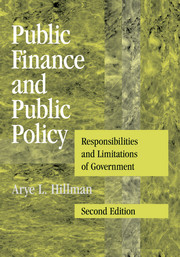Book contents
- Frontmatter
- Contents
- Preface to the Second Edition
- 1 MARKETS AND GOVERNMENTS
- 2 INSTITUTIONS AND GOVERNANCE
- 3 PUBLIC GOODS
- 4 PUBLIC FINANCE FOR PUBLIC GOODS
- 5 MARKET CORRECTIONS
- 6 VOTING
- 7 SOCIAL JUSTICE
- 8 ENTITLEMENTS
- 9 CHOICE OF TAXATION
- 10 THE NEED FOR GOVERNMENT
- TOPICS FOR DISCUSSION
- Author Index
- Subject Index
- References
9 - CHOICE OF TAXATION
- Frontmatter
- Contents
- Preface to the Second Edition
- 1 MARKETS AND GOVERNMENTS
- 2 INSTITUTIONS AND GOVERNANCE
- 3 PUBLIC GOODS
- 4 PUBLIC FINANCE FOR PUBLIC GOODS
- 5 MARKET CORRECTIONS
- 6 VOTING
- 7 SOCIAL JUSTICE
- 8 ENTITLEMENTS
- 9 CHOICE OF TAXATION
- 10 THE NEED FOR GOVERNMENT
- TOPICS FOR DISCUSSION
- Author Index
- Subject Index
- References
Summary
Taxation has been present in our investigation of public goods, externalities, paternalism, social justice, and entitlements: public spending requires that governments have tax revenue to spend, and taxes affect incentives and are the sources of efficiency losses through the excess burden of taxation. We also studied tax evasion as an application of the prisoners' dilemma of voluntary payment for public goods (people who evade payment of taxes are free riding on tax payments of honest taxpayers). We observed how the Laffer curve constrains the amount of tax revenue that governments can collect and that a leviathan government would seek to maximize tax revenue without regard for benefit for taxpayers (in which case, we might want to rethink judgments about tax evasion). In the different instances where we considered taxation, (1) there was a single tax rate, (2) there was a designated tax base, and (3) one government was involved in taxation and public spending. In section 1 of this chapter, we depart from a single tax to look at the structure of tax rates. Section 2 considers choice of the tax base – or choice of what to tax. On a number of occasions, beginning with the Tiebout locational-choice mechanism, we encountered fiscal federalism, that is, taxation and public spending in the context of intergovernmental fiscal relations. Section 3 brings together our prior observations on fiscal federalism and adds further perspectives and questions.
- Type
- Chapter
- Information
- Public Finance and Public PolicyResponsibilities and Limitations of Government, pp. 665 - 738Publisher: Cambridge University PressPrint publication year: 2009



